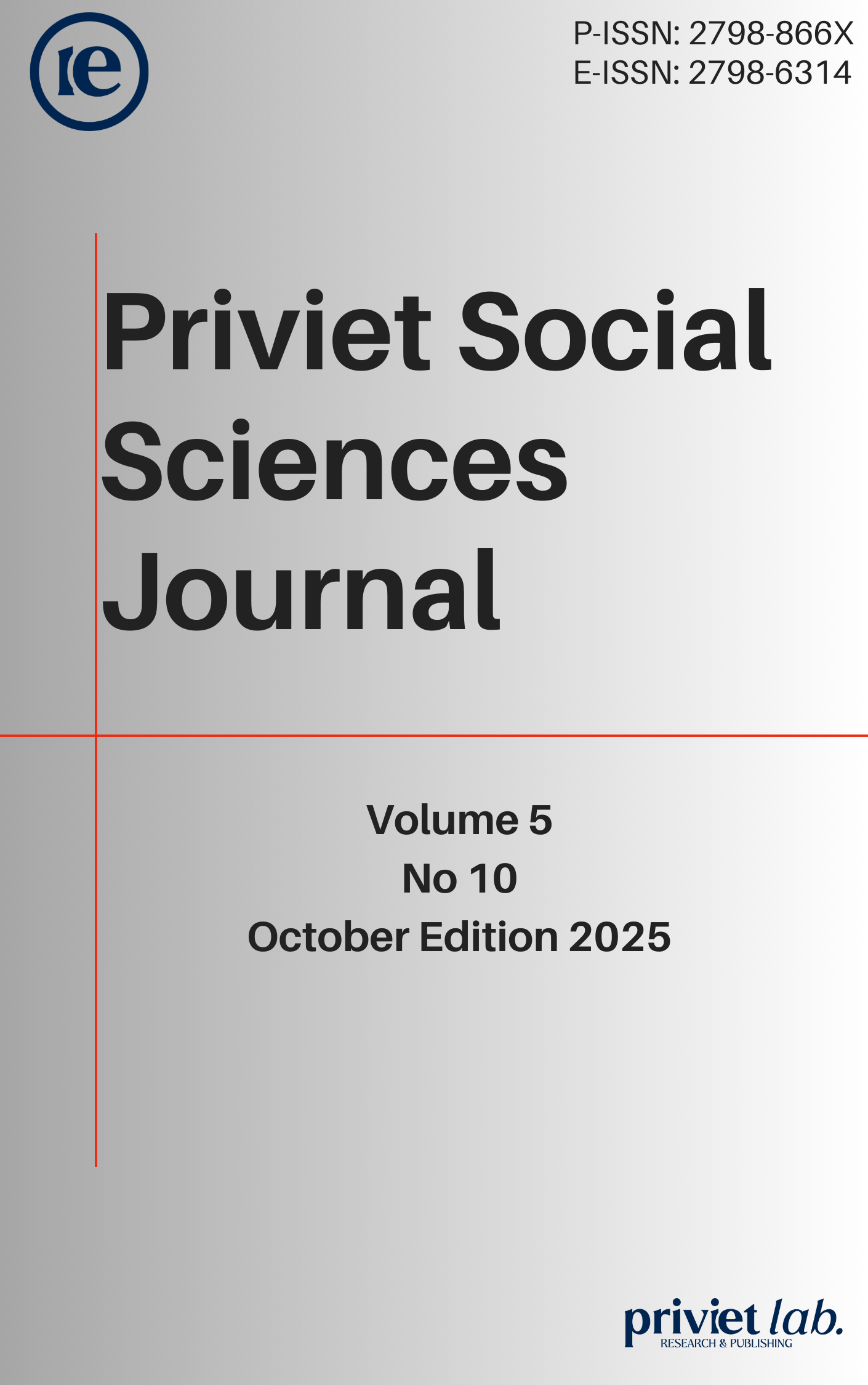Mapping the risk landscape of childhood obesity: A narrative review of behavioral and socioeconomic determinants
DOI:
https://doi.org/10.55942/pssj.v5i10.651Keywords:
childhood obesity, dietary behavior, parental influence, risk factors, socioeconomic statusAbstract
Childhood obesity is a critical global health concern with a rising prevalence in both developed and developing countries and is associated with substantial short- and long-term consequences, including metabolic, cardiovascular, and psychosocial disorders. This narrative review synthesizes recent evidence on the behavioral, familial, and socioeconomic determinants of childhood obesity to inform prevention strategies. Ten peer-reviewed articles published between 2015 and 2025 were reviewed, encompassing diverse populations from Asia, Europe, South America and Oceania. Studies met the inclusion criteria if they targeted children aged 2–18 years, defined overweight/obesity using standardized anthropometric measurements, and reported one or more risk factors. The extracted data were thematically analyzed into five domains: sociodemographic and family characteristics, dietary behaviors, physical activity and sedentary lifestyle, breastfeeding and early life exposures, and socioeconomic disparities. Across the included studies, unhealthy dietary patterns and insufficient physical activity were the most frequently cited modifiable risk factors, appearing in more than half of the studies. Maternal obesity, low parental education, and limited household income were consistently linked to higher obesity risk through both biological and environmental pathways, while short breastfeeding duration and cesarean delivery were recurrent early-life factors associated with increased prevalence. Socioeconomic disparities amplify exposure to obesogenic environments, particularly in disadvantaged communities. The findings indicate that childhood obesity is a multifactorial condition shaped by interdependent behavioral, familial, and structural determinants. Effective prevention requires equity-focused multisectoral strategies that integrate healthy eating promotion, physical activity encouragement, maternal and child health support, and interventions targeting the social determinants of health.
References
Ahmed, S. K., & Mohammed, R. A. (2025). Obesity: Prevalence, causes, consequences, management, preventive strategies and future research directions. Metabolism Open, 27(June), 100375. https://doi.org/10.1016/j.metop.2025.100375
Baran, J., Weres, A., Wyszyńska, J., Pitucha, G., Czenczek-Lewandowska, E., Rusek, W., Leszczak, J., & Mazur, A. (2020). 60 Minutes Per Day in Moderate To Vigorous Physical Activity As a Natural Health Protector in Young Population. International Journal of Environmental Research and Public Health, 17(23), 1–11. https://doi.org/10.3390/ijerph17238918
Drăgănescu, A. C., Dinulescu, A., Păcurar, D., Jinga, V., & Pleșca, D. A. (2025). Prevalence and Determinants of Overweight and Obesity Among Romanian Children Aged 5–17: A Cross-Sectional Study. Journal of Clinical Medicine, 14(10). https://doi.org/10.3390/jcm14103331
Firman, N., Wilk, M., Marszalek, M., Griffiths, L., Harper, G., & Dezateux, C. (2024). Is obesity more likely among children sharing a household with an older child with obesity? Cross-sectional study of linked National Child Measurement Programme data and electronic health records. BMJ Paediatrics Open, 8(1). https://doi.org/10.1136/bmjpo-2024-002533
Fruh, S. M. (2017). Obesity: Risk factors, complications, and strategies for sustainable long-term weight management. Journal of the American Association of Nurse Practitioners, 29, S3–S14. https://doi.org/10.1002/2327-6924.12510
Gautam, N., Chowdhury, A., Rahman, M. M., & Khanam, R. (2025). Socioeconomic inequalities in childhood and adolescent obesity in Australia: The role of behavioral and biological factors. PLoS ONE, 20(4 April), 1–23. https://doi.org/10.1371/journal.pone.0321861
Hermes, F. N., Nunes, E. E. M., & De Melo, C. M. (2022). Sleep, nutritional status and eating behavior in children: a review study. Revista Paulista de Pediatria, 40, 1–10. https://doi.org/10.1590/1984-0462/2022/40/2020479IN
Kar, N., & Kar, S. (2010). Exploring the complex relationship between obesity and mental health: A narrative review. Clinical Advisor, 18(July), 74–82. https://doi.org/10.4103/OJP.OJP
Karakitsiou, G., Plakias, S., Christidi, F., & Tsiakiri, A. (2024). Unraveling Childhood Obesity: A Grounded Theory Approach to Psychological, Social, Parental, and Biological Factors. Children, 11(9). https://doi.org/10.3390/children11091048
Kim, J. Y., Song, K., Choi, Y., Choi, B. S., & Chae, H. W. (2025). Analysis of risk factors affecting obesity in Korean adolescents: based on the 2017–2020 Korea national health and nutrition examination survey. Frontiers in Nutrition, 12(April). https://doi.org/10.3389/fnut.2025.1554218
Kondolot, M., Poyrazoǧlu, S., Horoz, D., Borlu, A., Altunay, C., Balcl, E., Öztürk, A., Mazlcloǧlu, M. M., & Kurtoǧlu, S. (2017). Risk factors for overweight and obesity in children aged 2-6 years. Journal of Pediatric Endocrinology and Metabolism, 30(5), 499–505. https://doi.org/10.1515/jpem-2016-0358
Kurspahić-Mujčić, A., & Mujčić, A. (2020). Factors associated with overweight and obesity in preschool children. Medicinski Glasnik, 17(2), 538–543. https://doi.org/10.17392/1175-20
Larson, N., Miller, J. M., Eisenberg, M. E., Watts, A. W., Story, M., & Neumark-Sztainer. (2018). Multicontextual correlates of energy-dense, nutrient-poor snack food consumption by adolescents. HHS Public Access, 11(5), 23–34. https://doi.org/10.1016/j.appet.2017.01.008.Multicontextual
Li, H., Xiang, X., Yi, Y., Yan, B., Yi, L., Ding, N., Yang, J., Gu, Z., Luo, Q., Huang, Y., Fan, L., & Xiang, W. (2024). Epidemiology of obesity and influential factors in China: a multicenter cross-sectional study of children and adolescents. BMC Pediatrics, 24(1), 1–12. https://doi.org/10.1186/s12887-024-04970-1
Li, S., Mohamed Nor, N., & Kaliappan, S. R. (2024). Do maternal socioeconomic status influence child overweight? Heliyon, 10(2). https://doi.org/10.1016/j.heliyon.2024.e24630
Lipps, C., Lawson, M. M., McKibben, N. S., Brady, J., & Working, Z. M. (2025). The Impact of Sleep Deprivation on Orthopaedic Surgeons: A Systematic Review. Journal of Sleep Research. https://doi.org/10.1111/jsr.70025
Liu, F., Lv, D., Wang, L., Feng, X., Zhang, R., Liu, W., & Han, W. (2022). Breastfeeding and overweight/obesity among children and adolescents: a cross-sectional study. BMC Pediatrics, 22(1), 1–8. https://doi.org/10.1186/s12887-022-03394-z
Liu, Y., Gu, Y., Mu, J., Duan, Z., Wang, X., Ren, X., Liu, L., Xu, J., Zhang, C., Zhou, S., Ma, N., Yuan, L., & Wang, Y. (2025). Relationship between breastfeeding duration, lifestyle and obesity in children aged 3–16 years: a cross-sectional study. Frontiers in Nutrition, 12(June), 1–9. https://doi.org/10.3389/fnut.2025.1598141
Ma, L., Xu, H., Zhang, Z., Li, L., Lin, Z., & Qin, H. (2023). Nutrition knowledge, attitudes, and dietary practices among parents of children and adolescents in Weifang, China: A cross-sectional study. Preventive Medicine Reports, 35(September), 102396. https://doi.org/10.1016/j.pmedr.2023.102396
Mahmood, L., Flores-Barrantes, P., Moreno, L. A., Manios, Y., & Gonzalez-Gil, E. M. (2021). The influence of parental dietary behaviors and practices on children’s eating habits. Nutrients, 13(4), 1–13.
Pan, X., Jiang, C., Wang, W., & Lin, J. (2025). Lifestyle factors associated with being overweight and obesity in children and adolescents: a cross-sectional study in Zhejiang, China. Frontiers in Public Health, 13(March), 1–9. https://doi.org/10.3389/fpubh.2025.1551099
Portela, D. S., Vieira, T. O., Matos, S. M. A., de Oliveira, N. F., & Vieira, G. O. (2015). Maternal obesity, environmental factors, cesarean delivery and breastfeeding as determinants of overweight and obesity in children: Results from a cohort. BMC Pregnancy and Childbirth, 15(1), 1–10. https://doi.org/10.1186/s12884-015-0518-z
Rankin, J., Matthews, L., Cobley, S., Han, A., Sanders, R., Wiltshire, H. D., & Baker, J. S. (2016). Psychological consequences of childhood obesity: psychiatric comorbidity and prevention. Adolescent Health, Medicine and Therapeutics, Volume 7, 125–146. https://doi.org/10.2147/ahmt.s101631
Rousham, E. K., Goudet, S., Markey, O., Griffiths, P., Boxer, B., Carroll, C., Petherick, E. S., & Pradeilles, R. (2022). Unhealthy Food and Beverage Consumption in Children and Risk of Overweight and Obesity: A Systematic Review and Meta-Analysis. Advances in Nutrition, 13(5), 1669–1696. https://doi.org/10.1093/advances/nmac032
Sandri, E., Bernalte Martí, V., Piredda, M., Cantín Larumbe, E., Cerdá Olmedo, G., Cangelosi, G., Sguanci, M., & Mancin, S. (2025). A Comprehensive Analysis of the Impact of Binge Eating Disorders on Lifestyle in Spain. Psychiatry International, 6(1). https://doi.org/10.3390/psychiatryint6010024
Smith, J. D., Fu, E., & Kobayashi, M. A. (2020). Prevention and Management of Childhood Obesity and its Psychological and Health Comorbidities. Annual Review of Clinical Psychology, 16, 351–378. https://doi.org/10.1146/annurev-clinpsy-100219-060201.Prevention
Tirthani, E., Said, M., & Rehman, A. (2021). Genetics: A Starting Point for the Prevention and the Treatment of Obesity. Nutrients, 15(2782), 1–16. https://doi.org/10.3390/nu15122782
Tsochantaridou, A., Sergentanis, T. N., Grammatikopoulou, M. G., Merakou, K., Vassilakou, T., & Kornarou, E. (2023). Publicidad de alimentos y elecciones dietéticas en adolescentes: una descripción general de estudios recientes. Children, 10(3), 442.
Umano, G. R., Bellone, S., Buganza, R., Calcaterra, V., Corica, D., Sanctis, L. De, Sessa, A. Di, Faienza, M. F., Improda, N., Licenziati, M. R., Manco, M., Ungaro, C., Urbano, F., & Valerio, G. (2025). Early Roots of Childhood Obesity : Risk Factors , Mechanisms , and Prevention Strategies. International Journal of Molecular Science, 26(7388), 1–41. https://doi.org/10.3390/ijms26157388
van Sluijs, E. M. F., Ekelund, U., Crochemore-Silva, I., Guthold, R., Ha, A., Lubans, D., Oyeyemi, A. L., Ding, D., & Katzmarzyk, P. T. (2021). Physical activity behaviours in adolescence: current evidence and opportunities for intervention. The Lancet, 398(10298), 429–442. https://doi.org/10.1016/S0140-6736(21)01259-9
Verma, M., Kapoor, N., Senapati, S., Singh, O., Bhadoria, A. S., Khetarpal, P., Kumar, S., Bansal, K., Ranjan, R., Kakkar, R., & Kalra, S. (2025). Comprehending the Epidemiology and Aetiology of Childhood Obesity: Integrating Life Course Approaches for Prevention and Intervention. Diabetes Therapy, 16(6), 1177–1206. https://doi.org/10.1007/s13300-025-01734-7
Vilar-Compte, M., Burrola-Méndez, S., Lozano-Marrufo, A., Ferré-Eguiluz, I., Flores, D., Gaitán-Rossi, P., Teruel, G., & Pérez-Escamilla, R. (2021). There is an increasing global trend towards urbanization. In general, there are less food access issues in urban than rural areas, but this “urban advantage” does not benefit the poorest who face disproportionate barriers to accessing healthy food and hav. International Journal for Equity in Health, 20(1).
Williams, A. S., Ge, B., Petroski, G., Kruse, R. L., McElroy, J. A., & Koopman, R. J. (2018). Socioeconomic status and other factors associated with childhood obesity. Journal of the American Board of Family Medicine, 31(4), 514–521. https://doi.org/10.3122/jabfm.2018.04.170261
Yun, Y. J., Kwon, Y. J., Lee, Y., Heo, S. J., & Lee, J. W. (2024). Association of dietary habits with general and abdominal obesity in Korean children and adolescents: cluster analysis of nationwide population survey data. Frontiers in Endocrinology, 15(September), 1–9. https://doi.org/10.3389/fendo.2024.1424761
Zong, B., Li, L., Cui, Y., & Shi, W. (2024). Effects of outdoor activity time, screen time, and family socioeconomic status on physical health of preschool children. Frontiers in Public Health, 12(August). https://doi.org/10.3389/fpubh.2024.1434936
Downloads
Published
How to Cite
Issue
Section
License
Copyright (c) 2025 Anwar Lubis

This work is licensed under a Creative Commons Attribution 4.0 International License.

















